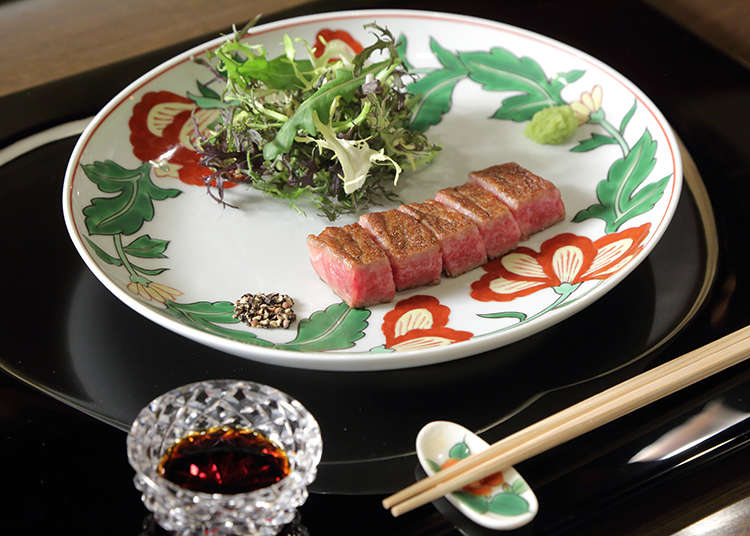
When you think of Japanese gourmet food, what comes to mind? The first images that may come to mind are probably “sushi,” “tempura,” and “soba noodles”— but after that, wagyu is a sure bet! The quality of wagyu cows which are carefully raised and nurtured by Japanese farmers is world-renowned. Once you put a slice of wagyu beef in your mouth, you'll surely be amazed at its exquisite deliciousness and fine taste! There are various ways of enjoying wagyu which has several brands based on where the cow was raised, and once you try it, you will surely ask for more. In this post, we'd like to introduce you to wagyu, which you simply have to try when you come to Japan. We will also talk about the “Wagyu Fair” which will be held in Tokyo from May 10 through July 10.
What is wagyu? Let's Learn More about its Brands and Cuts
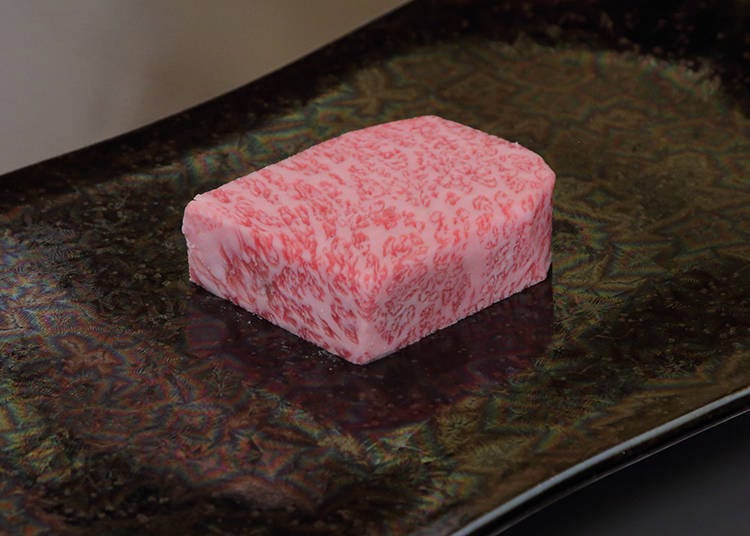
What is wagyu?
Wagyu is comprised of four breeds of cows that were crossbred from ancient Japanese cows and various varieties of cows of foreign origin, and whose quality has been refined through crossbreeding. Cows that have been crossbred from these four breeds are also considered wagyu. Also known as “the most expensive beef in the world,” wagyu beef is popular not only within Japan, but also with people from throughout the world. According to the “Survey on wagyu” conducted by Japan's leading restaurant search site, Gurunavi, more than 80% of Chinese visitors, and more than 50% of Taiwanese visitors to Japan have said that they have tried wagyu. As you can see, wagyu is one of the key foods that has come to represent Japanese cuisine, and is currently the pride of Japan.
Wagyu Brands and Grading
Wagyu is categorized according to its place of origin and how the cow was reared, and each brand's taste differs from other wagyu beef. Famous brands include Yonezawa beef, Omi beef, Kobe beef, Tajima beef, and Matzuzaka beef, some or all of which you may have heard of.
Wagyu is also graded, with “A5” as its highest rating. The letters A to C indicate the ratio of how much high-quality beef can be taken from one cow with “A” as the highest; and the numbers 1 to 5 represent how high the quality of the meat is, with “5” being the highest. Simply knowing the grading system can help those who are not so familiar with wagyu find restaurants with good-quality meat. Please do check the beef's grade when you eat wagyu.
Wagyu Cuts (Parts) and Their Rarity
Wagyu cuts and parts are divided into more than 20 types, and their tastes and textures also differ according to type. The taste will also change depending on the method of preparation, thus the numerous ways of enjoying wagyu are also what makes the meat a delicacy. Let's explore its particularly popular cuts and parts.
Sirloin: This is the meat around the upper back. This marbled beef with a superb sweetness is very tender, and is perfect for steaks along with “filet” and “rump” cuts.
Tongue: Characterized by a toothsome texture, this part becomes mouth-wateringly savoury when charcoal-grilled!
Misuji (top blade): Located near the shoulder and the upper leg, the top blade is a rare part, with only a small amount yielded by one cow. Its delicious richness typifies what meat should taste like, and is perfect for sukiyaki and stews.
Tail: A cow's tail is actually edible. Boiled well, it's tasty in soups and other dishes.
At a Restaurant in Japan Serving Wagyu
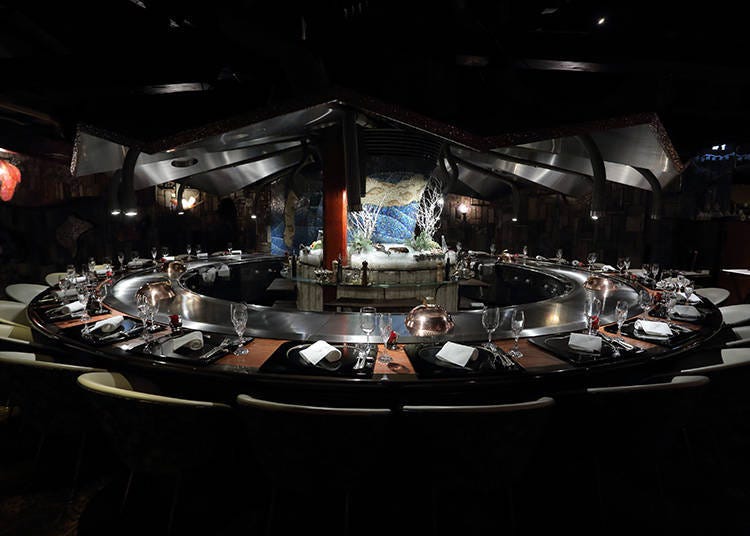
In order to convey the merits of wagyu even more, we went to Ginza Ukai-tei, a restaurant located in Tokyo to ask about wagyu.
Ginza Ukai-tei is a popular restaurant that serves teppanyaki grilled dishes made from carefully-selected ingredients, including wagyu, from all over Japan. It is often used as a place to entertain important persons from overseas, and is at the top of its class in Japan in terms of flavor and elegant taste. Guests delight in its interior which combines the sophisticated beauty of Japanese and Western design, in the expert techniques of its chefs, and in the sounds and aromas of sizzling meat. Once inside, a guest's five senses are fully engaged, prepping the mind and taste buds for an exciting meal!
Foreign Guests' Wagyu Preferences
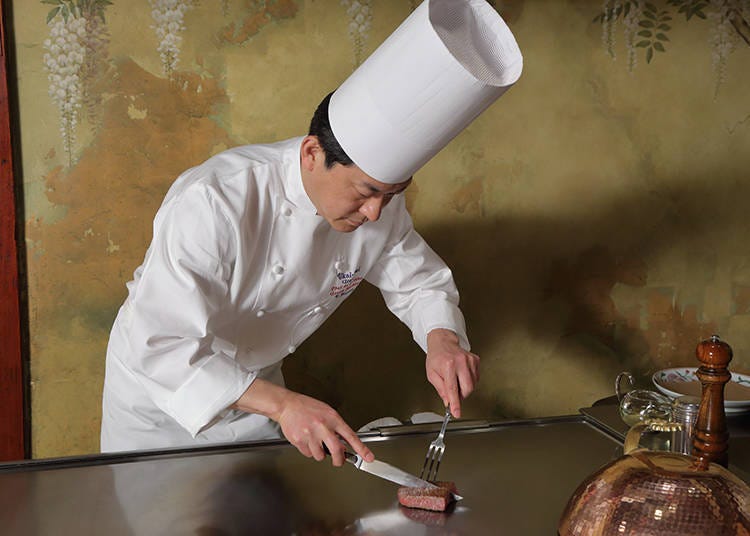
Ginza Ukai-tei says that their foreign guests mainly from Asian countries are increasing. Used to American beef, visitors from overseas are surprised at wagyu's exquisite flavors. Indeed, deliciousness knows no boundaries.
At this restaurant, wagyu is prepared and grilled according to the meat's quality and thickness, with special attention paid to the iron grill's exact temperature. In particular, “Ukai Select Steak” on the menu is a gem of a dish, composed of Japanese Black beef personally chosen by the head chef. The beef seemingly melts in the mouth spontaneously, with a delightful contrast in texture between its aromatic, seared surface and its juicy interior. Once you try wagyu, your view on meat may be completely overturned. Wagyu on its own is good enough to be the main reason for a visit to Japan.
Our Recommendations on Preparing and Enjoying Wagyu
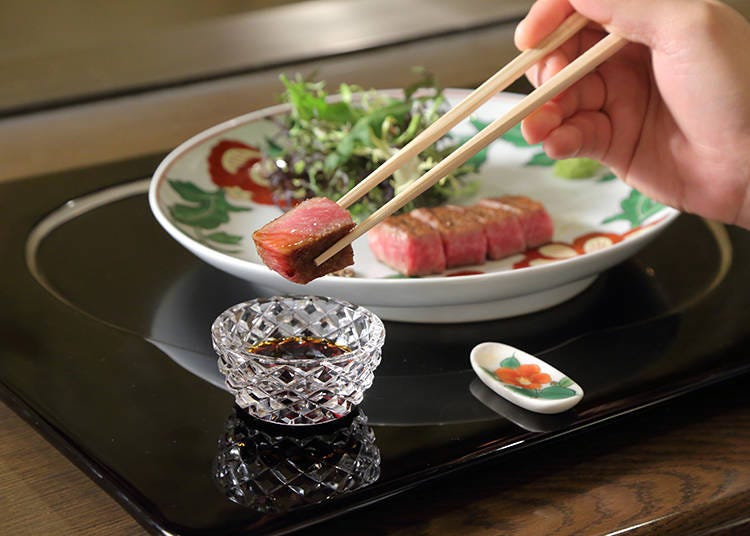
Wagyu can be prepared and cooked in many ways, but teppanyaki grilling is the most straightforward way of experiencing its delicious taste. This is the most ideal way for those who want to enjoy meat's natural, inherent taste. Seasoning wagyu of the utmost quality with only salt and pepper is delicious enough. However, if people were to eat wagyu in its hometown of Japan, there are surely many of those who would want a more “Japanese” experience. For these visitors, we recommend having wagyu with soy sauce, which is one of the five basic seasonings in Japanese cuisine. Soy sauce plays an excellent supporting role in bringing out meat's tastiness, so be sure to give it a try.
The soy sauce used at Ginza Ukai-tei is Kikkoman soy sauce. Made by such a well-established manufacturer, it was chosen for its reliability and safety. The fragrance and taste of soy sauce greatly varies depending on its ingredients and production method, but Kikkoman’s is characterized by its brilliant and crisp aroma. Ingredients with distinctive tastes such as meat and fish pair well with this soy sauce. Its aroma is retained even when heated at high temperatures, which makes it ideal for teppanyaki dishes.
Soy Sauce = Kikkoman
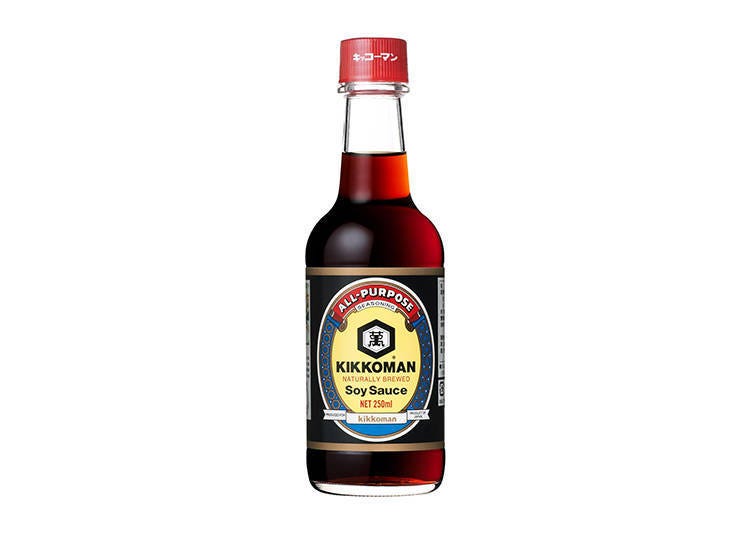
Kikkoman is one of Japan's largest food manufacturers. It produces a great variety of products, which of course includes soy sauce, a seasoning that's indispensable at Japanese dinner tables. In particular, Kikkoman holds the largest share in soy sauce sales and production domestically, and brand name recognition within Japan is very high. With a history spanning more than 300 years and a slogan of “seasoning your life,” Kikkoman continues to add flavor and taste to people's lives through food.
Kikkoman has been proactively expanding its business worldwide, with the creation of company bases in the United States and other countries since 1957. Even in cultures with plenty of meat dishes unlike Japan, soy sauce is well-liked and often used.
For those interested in soy sauce, please check out Kikkoman's “Soy Sauce Museum” which offers extensive information on the history of soy sauce and its production.
Please visit the “Wagyu Fair” which will be held in and around Tokyo!
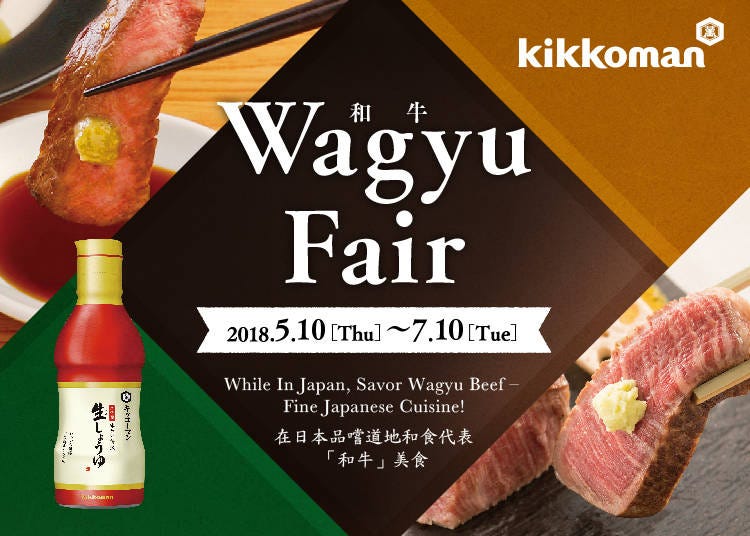
From its desire to convey the goodness of wagyu to foreign visitors, Kikkoman has decided to hold a “Wagyu Fair” from Thursday, May 10 to Tuesday, July 10, 2018!
In restaurants that serve wagyu and are located mainly in Tokyo and in three surrounding prefectures, you can enjoy superb dishes combining wagyu and Kikkoman soy sauce. With soy sauce that greatly brings out the deliciousness of meat, you can savor the depths of wagyu all the more. This fair is a must for those who want to enjoy gourmet Japanese cuisine! Please do take this opportunity to savor wagyu in its hometown of Japan.
- Category
*Prices and options mentioned are subject to change.
*Unless stated otherwise, all prices include tax.
Popular Tours & Activitiess
-

2025 Japan Autumn Color Report: Tokyo's Ginkgo Trees Starting to Glow
by: Timothy Sullivan
-

LaLaport TOKYO-BAY North Building Now Open: Shop, Dine & Enjoy Events at LaLa arena, Just 2 Stops from Disney
by: Wemmy Chau
-

A Travel Game Changer! Go Hands-Free Between Tokyo and Kyoto with LUGGAGE EXPRESS by JTB and JR Tokai
by: Guest Contributor
-

See Asakusa and Tokyo Skytree® in a New Light at the "Také Akari" Festival (Winter 2025-2026)
by: Guest Contributor
-

Black Friday 2025: These Are THE Japan Travel & Shopping Deals to Check Out
-

Get Ready to Catch 'Em All! First Ever Permanent Outdoor Pokémon Park Opening Near Tokyo!
-

Top 3 Shibuya Wagyu Restaurants for Great Japanese Beef Under $15!
-

Okonomiyaki: Try Japan’s Favorite Soul Food at an Authentic Teppanyaki Restaurant
-

Guide to Tokyo's Old Quarter: 7 Quaint Spots in Yanesen!
-

Osaka Food: 3 Crazy Mega Meals in Osaka! These Dishes Could Feed a Family
by: WESTPLAN
-

Aizu-Wakamatsu Sake Crawl: Enjoy the Heart of Fukushima's Sake Culture
-

Kobe Beef in Japan: 3 Best Restaurants Near Sannomiya Offering Affordably Priced Kobe Beef!
- #best sushi japan
- #what to do in odaiba
- #what to bring to japan
- #new years in tokyo
- #best ramen japan
- #what to buy in ameyoko
- #japanese nail trends
- #things to do japan
- #onsen tattoo friendly tokyo
- #daiso
- #best coffee japan
- #best japanese soft drinks
- #best yakiniku japan
- #japanese fashion culture
- #japanese convenience store snacks












